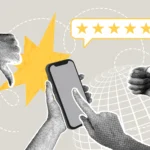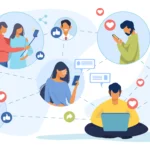We all remember the early days when big companies first introduced chatbots on their websites. And to be honest, back then, most people couldn’t wait to hit the “Speak with a real person” button.
At the time, it made sense. The issue wasn’t that a real person wasn’t behind the chat. It was that the responses we received simply weren’t good enough. Fast forward a few years, and the future is here. Gone are the days when sales and marketing relied solely on human interactions. Chatbots have taken center stage.
And it’s not just the big corporations using them anymore. Local businesses are embracing chatbots to streamline processes, boost revenue, and minimize human errors. These bots are no longer the expensive, clunky tools of the past. They’re now an essential part of modern marketing. If you don’t want to be left behind by your competitors, this guide will show you exactly how to leverage chatbots effectively in your marketing strategy.
What Are Chatbots?
Chatbots are software applications that simulate conversations with people, typically via text-based messages. In the past, they were primarily used for customer support, providing quick answers to common questions. But today, they’ve evolved into interactive sales assistants, guiding customers and driving conversions.
From websites and messaging apps to customer service portals and e-commerce stores, chatbots are everywhere. Thanks to their immediate and highly accurate responses, more and more customers rely on them to navigate their buying journey.
When it comes to the types of chatbots, we can separate them in two ways:
- Ruled-Based Chatbots: These chatbots work based on the pre-set rules. They are programmed to respond to specific commands. This means they can be limited to specific scenarios you set and people may not get all the information.
- AI-Powered Chatbots: Chatbots that utilize machine learning, especially natural language processing, to understand the intent behind the message and generate the perfect response. The most interesting part about these chatbots is that they learn and improve through time.
What is a Chatbot Marketing Strategy?
A chatbot marketing strategy is the process of using automation to connect with potential and existing customers. Think of a chatbot as a digital salesperson that never sleeps. It’s an employee that works 24/7. No holidays, no breaks, and constantly improving to generate more leads and sales for your business.
If you’re wondering whether people actually use chatbots, consider this: 80% of users engage with chatbots when given the option. That’s a massive audience you don’t want to ignore.
What Are the Benefits of Using Chatbots for Marketing?
Now that we’ve established that people actually use chatbots, let’s explore how they can benefit your business:
Engage and Qualify Leads
Our attention spans are getting shorter. If a website doesn’t capture our interest within seconds, we leave. Chatbots act as interactive attention-grabbers, asking relevant questions and offering assistance. By guiding users through a conversation, chatbots can determine whether a lead is genuinely interested and how best to assist them.
Direct High-Intent Leads to Sales
Many businesses struggle with website visitors who check prices but don’t convert into customers. Chatbots can intervene at the right moment, either by answering concerns, offering incentives, or connecting high-intent leads to a human sales rep.
Boost Engagement and Sales
Chatbots can suggest relevant products or services to customers who are already in the buying mindset. A well-placed recommendation or upsell can turn a casual browser into a paying customer.
Read more: How AI chatbots for wellness improve client engagement.
Read more: How to improve communication with you clients (beyond AI tools)
Segment Traffic Effectively
Even with a well-organized website, some visitors struggle to find what they need. Chatbots simplify this process by directly asking users what they’re looking for and guiding them to the right page, creating more opportunities for sales.
Provide 24/7 Availability
Customers might have questions at any time of day or night. A chatbot ensures that your business is always available, providing instant support without making customers wait for a human response.
Collect and Leverage Data for Insights
Since chatbots are software-driven, they excel at gathering and analyzing data. They can track customer behavior, favorite products, purchase frequency, and more. This allows your businesses to refine marketing strategies and personalize future interactions.

How to use chatbots in marketing
Now that you understand the benefits, let’s explore practical ways to integrate chatbots into your marketing strategy. And if you’re looking to try chatbots in your business, check out Referrizer’s AI Assistant to see how it can enhance your customer interactions and streamline operations.
Taking Orders
If you offer multiple products, chatbots can simplify the purchasing process by guiding customers through product selections, payments, and order confirmations. This not only enhances the user experience but also prevents potential drop-offs during checkout.
Scheduling Appointments
If your business requires bookings, chatbots can streamline the appointment-setting process. Instead of redirecting customers to a calendar, chatbots can interactively guide them through scheduling. Plus, this provides an opportunity to suggest additional services or upsells during the conversation.
Promoting Products and Services
Chatbots can act as virtual sales reps, pushing personalized promotions, discounts, or special offers at the right moment. If a user is lingering on a particular product page, a chatbot can nudge them with a limited-time discount or answer concerns that may be preventing them from making a purchase.
Distributing News and Updates
Need to share important updates with your audience? Chatbots can effectively deliver announcements, promotional offers, or company news in an engaging and interactive way. And if customers have questions about the update, the chatbot can handle them instantly.
Chatbot Marketing Examples
Chatbots can be incredibly versatile, providing tailored solutions for various local businesses. Here are some practical examples of how small and medium-sized businesses can use chatbots to enhance their marketing strategies:
Fitness Centers and Gyms
A gym chatbot can assist with membership sign-ups, class bookings, and even suggest personalized workout plans. It can also remind members about upcoming sessions or promote special training programs.
Salons and Spas
Instead of relying on phone calls or manual bookings, a salon chatbot can handle appointment scheduling, send reminders, and suggest related services such as an upsell from a haircut to a full styling package.
Restaurants and Cafes
A chatbot can help customers make reservations, browse menus, and even place online orders. For example, a café might use a chatbot to recommend daily specials based on customer preferences or previous orders, encouraging repeat visits.
Local Retail Stores
Retail businesses can use chatbots to answer product inquiries, provide recommendations based on customer browsing history, and even offer personalized discounts to increase conversions.
Auto Repair Shops
Car repair businesses can use chatbots to schedule maintenance appointments, provide estimated service costs, and answer frequently asked questions about vehicle repairs.
By leveraging chatbots in these ways, local businesses can improve customer engagement, streamline operations, and boost revenue.
Final Thoughts
Chatbots have transitioned from being optional tools to becoming an essential part of modern marketing strategies. Whether you’re looking to increase engagement, generate leads, or streamline customer interactions, chatbots provide an effective, scalable solution. As technology continues to evolve, businesses that leverage chatbot marketing will gain a competitive edge, so don’t wait. Start integrating chatbots into your marketing today and watch your business thrive in 2025 and beyond!





